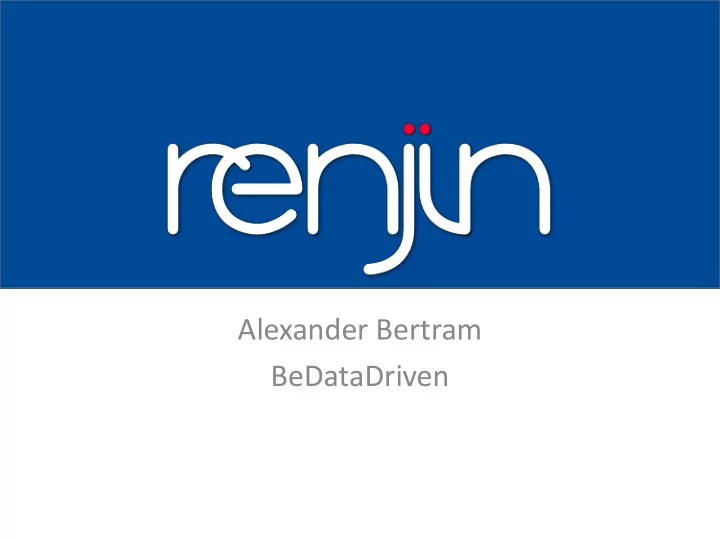

Alexander Bertram BeDataDriven Renjin: The new R interpreter built on the JVM
What? Renjin is a new interpreter for the R language. Core & Base GNU Builtins R Language Written in Packages Stats Java Graphics
Why? Performance Memory Easier Integration Parallel Speed ism Java Virtual Machine JIT GC tools 500k libs
Sure, but why Renjin? bigvis + High performance for specific applications biglm Packages - Require rewriting existing code scaleR - Limited applicability scaleR + Marginal improvements for all code - Unable to address underlying limitations Forks pqR of the GNU R interpreter
What do I get, like, today?
Flexible Command-Line Embeddable Interpreter Java Library > renjin – f myscript.R Web-based REPL
Multiple In-process sessions, Shared Data Web Request Web Request Web Request Renjin Session 1 Renjin Session 2 Renjin Session 3 Vector Immutable Data Java Virtual Machine Structures
Memory Efficiency # GNU R Renjin x <- runif(1e8) # +721 MB + 721 MB y <- x + 1 # +761 MB comment(y) <- "important!" # +763 MB - getAttributes() Vector Interface - length() - getElement(int index)
packages.renjin.org Proper Pre-built Dependency Package Management Repository Translation of Automated C/Fortran to Testing of JVM Bytecode Renjin
Seamless Access to Java/Scala Classes import(com.acme.Customer) bob <- Customer$new(name='Bob', age=36) carol <- Customer$new(name='Carole', age=41) bob$name <- "Bob II" cat(c("Name: ", bob$name, "; Age: ", bob$age))
Simple to embed in larger systems // create a script engine manager ScriptEngineManager factory = new ScriptEngineManager(); // create an R engine ScriptEngine engine = factory.getEngineByName("Renjin"); // load package from classpath engine.eval( “library(survey)" ); // evaluate R code from String engine.eval("print('Hello, World')"); // evaluate R script on disk engine.eval(new FileReader("myscript.R")); // evaluate R script from classpath engine.eval(new InputStreamReader( getClass().getResourceAsStream("myScript.R")));
Package Development in Java @DataParallel @Deferrable public static String chartr( String oldChars , String newChars , @Recycle String x ) { StringBuilder translation = new StringBuilder ( x . length ()); for(int i = 0 ; i != x . length ();++ i ) { int codePoint = x . codePointAt ( i ); int charIndex = oldChars . indexOf ( codePoint ); if( charIndex == - 1 ) { translation . appendCodePoint ( codePoint ); } else { translation . appendCodePoint ( newChars . codePointAt ( charIndex )); } } return translation . toString (); }
Under the hood
Specialized Execution Modes “Slow” - Supports full dynamism of R AST - Compute on the language Interpreter - Acts like a query planner Vector - Batches, auto-parallelizes vector Pipeliner workflows - Partially evaluates & Scalar compiles loop bodies, Compiler apply functions to JVM byte code
Queuing up work for the Vector Pipeliner x <- runif (1e6) y <- sqrt (x + 1) z <- mean (y) - mean (x) attr (z, 'comments') <- 'still not computed' print ( length (z)) # prints "1" # but doesn't #evaluate the mean print (z) # triggers computation
x <- runif (1e6) y <- sqrt (x + 1) z <- mean (y) - mean (x)
Real-world case study: Distance Correlation in the Energy Package
Distance correlation : robust measure of association. Zero if and only if variables are independent.
dcor <- function (x, y, index = 1) { x <- as.matrix ( dist (x)) y <- as.matrix ( dist (y)) n <- nrow (x) dist(x) m <- nrow (y) Evaluates as a dims <- c (n, ncol (x), ncol (y)) view Akl <- function (x) { d <- as.matrix (x)^index m <- rowMeans (d) M <- mean (d) Defer a <- sweep (d, 1, m) b <- sweep (a, 2, m) rowMeans(x) return (b + M) until later } A <- Akl(x) B <- Akl(y) dCov <- sqrt ( mean (A * B)) dVarX <- sqrt ( mean (A * A)) dVarY <- sqrt ( mean (B * B)) Need to V <- sqrt (dVarX * dVarY) if (V > 0) evaluate dCor <- dCov/V else dCor <- 0 return ( list (dCov = dCov, dCor = dCor, dVarX = dVarX, dVarY = dVarY)) }
Run time of distance correlation of 10 pairs of variables 200 180 GNU R C Renjin 160 140 120 100 80 60 40 20 0 1000 2000 5000 10000 Number of Observations
Where do we go from here?
Inspired by…
Join us! Download & Test Contract us Contribute! for Commercial Support Sponsor Development! > Renjin.org
Recommend
More recommend